Vegan Baking Ingredients Market
Vegan Baking Ingredients Market Size and Share Forecast Outlook 2025 to 2035
Vegan baking ingredients market is projected to grow from USD 510.0 million in 2025 to USD 940.0 million by 2035, at a CAGR of 6.8%. Egg replacers & binders will dominate with a 38.0% market share, while industrial bakery customers will lead the channel segment with a 58.0% share.
Vegan Baking Ingredients Market Forecast and Outlook 2025 to 2035
The global vegan baking ingredients market is valued at USD 510 million in 2025. It is slated to reach USD 940 million by 2035, recording an absolute increase of USD 430.0 million over the forecast period. This translates into a total growth of 84.3%, with the market forecast to expand at a compound annual growth rate (CAGR) of 6.8% between 2025 and 2035.
The overall market size is expected to grow by nearly 1.84X during the same period, supported by increasing plant-based diet adoption, growing vegan lifestyle trends, and rising demand for sustainable and cruelty-free baking solutions across diverse commercial bakery, retail, and foodservice applications.
Quick Stats for Vegan Baking Ingredients Market
- Vegan Baking Ingredients Market Value (2025): USD 510 million
- Vegan Baking Ingredients Market Forecast Value (2035): USD 940 million
- Vegan Baking Ingredients Market Forecast CAGR: 6.8%
- Leading Product Type in Vegan Baking Ingredients Market: Egg replacers & binders
- Key Growth Regions in Vegan Baking Ingredients Market: North America, Europe, and Asia Pacific
- Key Players in Vegan Baking Ingredients Market: Puratos, Corbion, ADM, Ingredion, Tate & Lyle, Cargill
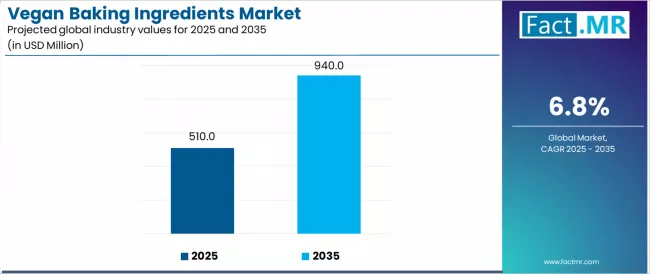
Between 2025 and 2030, the vegan baking ingredients market is projected to expand from USD 510 million to USD 702.7 million, resulting in a value increase of USD 192.7 million, which represents 44.8% of the total forecast growth for the decade. This phase of development will be shaped by increasing plant-based consumer adoption, rising commercial bakery vegan product development, and growing demand for functional and nutritionally enhanced vegan baking solutions. Commercial bakeries and food manufacturers are expanding their vegan ingredient sourcing capabilities to address the growing demand for ethical and sustainable baking alternatives that ensure performance consistency and consumer satisfaction.
Vegan Baking Ingredients Market Key Takeaways
| Metric | Value |
|---|---|
| Estimated Value in (2025E) | USD 510 million |
| Forecast Value in (2035F) | USD 940 million |
| Forecast CAGR (2025 to 2035) | 6.8% |
From 2030 to 2035, the market is forecast to grow from USD 702.7 million to USD 940 million, adding another USD 237.3 million, which constitutes 55.2% of the overall ten-year expansion. This period is expected to be characterized by the expansion of premium artisanal applications, the development of enhanced functionality formulations, and the growth of specialized applications for plant-based meat alternatives and dairy-free dessert products. The growing adoption of clean-label formulations and biotechnology-derived ingredients will drive demand for vegan baking ingredients with improved performance characteristics and sustainable production credentials.
Between 2020 and 2025, the vegan baking ingredients market experienced rapid growth, driven by increasing plant-based diet adoption and growing recognition of vegan ingredients as essential alternatives for enhancing product inclusivity and meeting ethical consumption requirements across diverse commercial and retail baking applications. The market developed as food manufacturers and commercial bakeries recognized the potential for vegan ingredient technology to replace animal-derived components, support ethical positioning, and enable product portfolio expansion while maintaining taste quality and functional performance. Technological advancement in plant protein functionality and binding systems began emphasizing the critical importance of maintaining texture quality and baking performance in challenging commercial production environments.
Why is the Vegan Baking Ingredients Market Growing?
Market expansion is being supported by the increasing global adoption of plant-based diets driven by environmental consciousness and ethical consumption preferences, alongside the corresponding need for effective animal product alternatives that can enhance baking performance, enable ethical product positioning, and maintain quality standards across various commercial bakery, retail, and foodservice applications. Modern bakery operators and food manufacturers are increasingly focused on implementing vegan ingredient solutions that can provide functional effectiveness, support sustainability objectives, and ensure consumer satisfaction while meeting comprehensive ethical and environmental compliance requirements.
The growing emphasis on sustainability and environmental responsibility is driving demand for vegan baking ingredients that can support carbon footprint reduction, enable cruelty-free formulations, and ensure comprehensive environmental stewardship. Commercial operators' preference for ingredients that combine functional performance with ethical credentials and environmental sustainability is creating opportunities for innovative vegan baking ingredient implementations. The rising influence of younger consumer demographics and health-conscious lifestyle trends is also contributing to increased adoption of vegan baking solutions that can provide ethical alignment benefits without compromising taste satisfaction or baking performance.
Segmental Analysis
The market is segmented by product, ingredient source, and channel. By product, the market is divided into egg replacers & binders, plant-based fats & shortenings, and dairy replacers. Based on ingredient source, the market is categorized into soy & pea proteins, coconut/oil blends, and specialty hydrocolloids. By channel, the market includes industrial bakery customers, retail/foodservice, and online ingredient sales. Regionally, the market is divided into North America, Europe, Asia Pacific, Latin America, and Middle East & Africa.
By Product, the Egg Replacers & Binders Segment Leads the Market
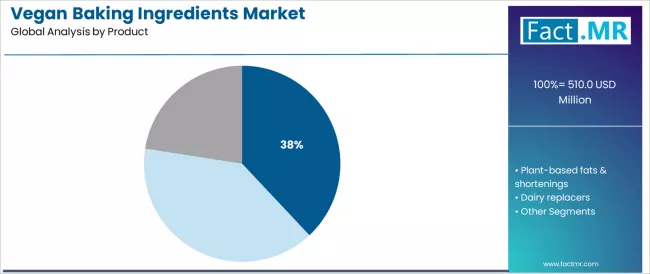
The egg replacers & binders segment is projected to maintain its leading position in the vegan baking ingredients market in 2025 with a 38% market share, reaffirming its role as the preferred product category for functional baking applications and structural performance requirements. Commercial bakeries and food manufacturers increasingly utilize egg replacement solutions for their proven binding effectiveness, established performance reliability, and demonstrated capability in maintaining texture quality while supporting vegan positioning and ethical compliance. Egg replacer technology's proven versatility and application effectiveness directly address the industry requirements for functional ingredient alternatives and comprehensive vegan baking solutions across diverse product categories and processing conditions.
This product segment forms the foundation of modern vegan baking operations, as it represents the ingredient category with the greatest contribution to structural integrity and established commercial acceptance across multiple baking applications and product formats. Food industry investments in plant-based binding technologies continue to strengthen adoption among commercial bakeries and ingredient suppliers. With growing consumer expectations for vegan alternatives and regulatory support for plant-based ingredients, egg replacers and binders align with both functional performance requirements and ethical positioning objectives, making them the central component of comprehensive vegan baking strategies.
By Channel, the Industrial Bakery Customers Segment Dominates Market Demand
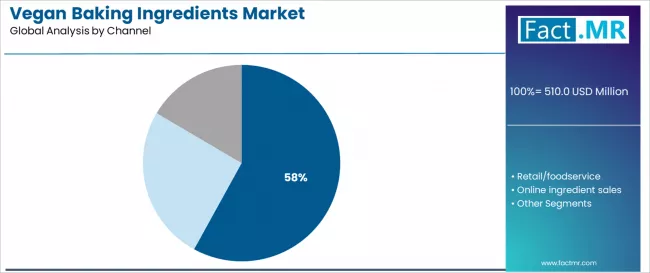
The industrial bakery customers channel segment is projected to represent the largest share of vegan baking ingredients demand in 2025 with a 58% market share, underscoring its critical role as the primary distribution channel for vegan ingredient adoption across commercial bakeries, large-scale food manufacturers, and industrial baking operations. Industrial customers prefer vegan baking ingredients for their scalability advantages, cost optimization potential, and ability to support large-volume production while maintaining consistent quality and ethical positioning. Positioned as essential solutions for modern commercial baking operations, vegan ingredients offer both operational efficiency and market positioning benefits.
The segment is supported by continuous innovation in vegan ingredient technology and the growing availability of industrial-grade formulations that enable superior production consistency with enhanced functional performance and processing compatibility. Additionally, industrial bakery operators are investing in comprehensive vegan ingredient programs to support increasingly demanding consumer expectations and corporate sustainability requirements. As plant-based trends accelerate and ethical sourcing becomes critical, the industrial bakery customers channel will continue to dominate the market while supporting advanced vegan ingredient utilization and production optimization strategies.
What are the Drivers, Restraints, and Key Trends of the Vegan Baking Ingredients Market?
The vegan baking ingredients market is advancing steadily due to increasing demand for plant-based food solutions driven by environmental consciousness and growing adoption of vegan lifestyles that require effective animal product alternatives providing functional performance and ethical compliance across diverse commercial bakery, retail, and foodservice applications. However, the market faces challenges, including higher costs compared to conventional ingredients and performance limitations, supply chain constraints related to specialized ingredient sourcing and processing requirements, and technical challenges regarding functionality matching and taste neutrality. Innovation in plant protein technologies and binding system optimization continues to influence product development and market expansion patterns.
Expansion of Plant-Based Food Industry and Alternative Protein Applications
The growing expansion of the plant-based food industry is driving demand for vegan baking ingredients that address formulation requirements for plant-based meat alternatives, dairy-free desserts, and specialty vegan products requiring advanced binding, texturing, and fat replacement capabilities. Plant-based food manufacturers require specialized vegan ingredients that deliver superior functionality with enhanced protein content, improved texture profiles, and processing stability under challenging production conditions. Food companies are increasingly recognizing the competitive advantages of advanced vegan ingredient integration for product innovation and market differentiation, creating opportunities for specialized formulations designed for emerging plant-based food categories and premium applications.
Integration of Clean-Label and Functional Ingredient Technologies
Modern vegan ingredient manufacturers are incorporating clean-label principles and functional enhancement technologies to address consumer transparency expectations, improve nutritional profiles, and support comprehensive health positioning through optimized ingredient sourcing and processing methods. Leading companies are developing organic ingredient lines, implementing minimal processing approaches, and advancing functional ingredient integration that enhances nutritional content while maintaining vegan compliance and performance standards. These approaches improve market positioning while enabling new opportunities, including premium retail applications, health-focused product development, and specialized dietary applications. Advanced clean-label integration also allows manufacturers to support comprehensive consumer satisfaction objectives and market differentiation beyond traditional animal product replacement positioning.
Development of Biotechnology-Derived and Novel Ingredient Solutions
The expansion of biotechnology applications and novel ingredient development is driving demand for vegan baking ingredients with enhanced functionality characteristics and improved performance profiles that exceed traditional plant-based ingredient limitations. These advanced applications require specialized biotechnology platforms with enhanced functional specifications that support superior baking performance while maintaining vegan compliance, creating premium market segments with differentiated value propositions. Manufacturers are investing in fermentation technologies and precision ingredient development to serve demanding commercial baking applications while supporting innovation in functional food development and advanced nutrition optimization.
Analysis of the Vegan Baking Ingredients Market by Key Countries
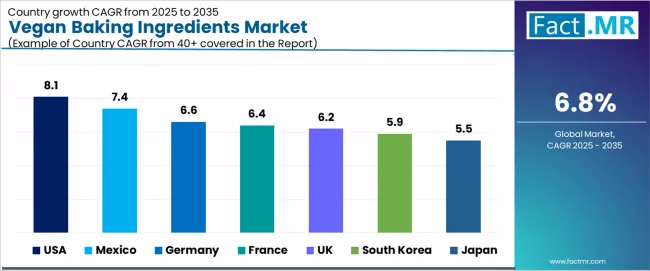
| Country | CAGR (2025-2035) |
|---|---|
| USA | 8.1% |
| Mexico | 7.4% |
| Germany | 6.6% |
| France | 6.4% |
| UK | 6.2% |
| South Korea | 5.9% |
| Japan | 5.5% |
The vegan baking ingredients market is experiencing solid growth globally, with the USA leading at an 8.1% CAGR through 2035, driven by expanding plant-based food industry, growing vegan consumer demographics, and increasing commercial bakery adoption of sustainable ingredient solutions. Mexico follows at 7.4%, supported by rising health consciousness, expanding food processing capabilities, and growing export market development for plant-based products. Germany shows growth at 6.6%, emphasizing sustainability leadership, organic market development, and advanced ingredient technology innovation. France demonstrates 6.4% growth, supported by premium food culture, artisanal baking traditions, and comprehensive environmental sustainability initiatives. The UK records 6.2%, focusing on ethical consumption trends, retail chain sustainability requirements, and plant-based market expansion. South Korea exhibits 5.9% growth, emphasizing premium imported ingredients, health trend adoption, and expanding Western dietary preferences. Japan shows 5.5% growth, supported by quality-focused consumers, health consciousness trends, and premium ingredient positioning strategies.
The report covers an in-depth analysis of 40+ countries top-performing countries are highlighted below.
USA Leads Global Market Growth with Plant-Based Industry Expansion and Innovation Leadership
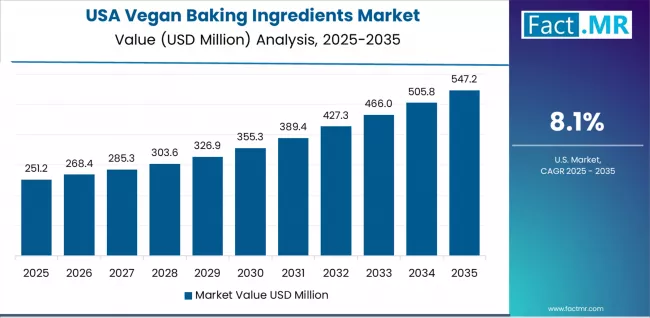
Revenue from vegan baking ingredients in the USA is projected to exhibit exceptional growth with a CAGR of 8.1% through 2035, driven by expanding plant-based food industry and rapidly growing vegan consumer demographics supported by comprehensive retail availability and increasing investment in ingredient innovation technologies. The country's massive food manufacturing sector and increasing focus on sustainable ingredient solutions are creating substantial demand for effective vegan alternatives. Major ingredient manufacturers and commercial bakeries are establishing comprehensive vegan ingredient development capabilities to serve both growing domestic markets and international export opportunities.
- Growing vegan consumer demographics and plant-based diet adoption are driving demand for vegan baking ingredients throughout major metropolitan markets and health-conscious consumer communities across natural food retailers, mainstream supermarkets, and specialty ingredient suppliers.
- Strong plant-based food industry growth and expanding commercial bakery adoption are supporting the rapid integration of vegan ingredient technologies among manufacturers seeking sustainable positioning and ethical market alignment.
- Advanced food technology research and innovation capabilities are supporting vegan ingredient development including protein functionality optimization, binding system enhancement, and processing performance improvement throughout major research institutions and corporate development centers.
- Comprehensive retail market penetration and mainstream availability trends are enabling vegan ingredient adoption across diverse consumer segments while maintaining quality standards and cost competitiveness for commercial applications.
Mexico Demonstrates Strong Market Potential with Food Processing Growth and Export Development
Revenue from vegan baking ingredients in Mexico is expanding at a CAGR of 7.4%, supported by rapid food processing industry expansion, growing health consciousness among urban consumers, and increasing export market development for plant-based food products. The country's expanding manufacturing capabilities and agricultural ingredient availability are driving sophisticated vegan ingredient utilization throughout commercial food operations. Leading multinational companies and domestic manufacturers are establishing extensive vegan ingredient sourcing and application development facilities.
- Rapid food processing industry growth and expanding commercial bakery capabilities are creating opportunities for vegan ingredient adoption throughout major industrial centers and food production facilities serving domestic and export markets.
- Growing health consciousness and environmental awareness among urban consumers are driving demand for plant-based ingredient solutions supporting ethical consumption and sustainability objectives across metropolitan markets.
- Agricultural resource availability and traditional plant-based ingredient knowledge are supporting vegan ingredient development including indigenous protein sources and sustainable processing methods throughout major agricultural regions.
- Expanding export opportunities and international market development are enabling Mexican vegan ingredient producers to access North American and global markets while maintaining cost competitiveness and quality standards.
Germany Emphasizes Sustainability Leadership with Organic Innovation and Technology Excellence
Revenue from vegan baking ingredients in Germany is expanding at a CAGR of 6.6%, supported by the country's sustainability leadership, established organic food markets, and advanced ingredient technology development capabilities supporting comprehensive environmental and ethical compliance requirements. Germany's regulatory excellence and innovation focus are supporting investment in high-end vegan ingredient solutions. Major chemical companies and specialty ingredient manufacturers are establishing comprehensive sustainability programs incorporating renewable sourcing and environmental stewardship.
- Advanced sustainability standards and comprehensive environmental regulations are creating structured opportunities for vegan ingredient development throughout major manufacturing centers and organic food production facilities.
- Strong organic food market and established ethical consumption preferences are driving adoption of certified organic vegan ingredients meeting stringent European quality standards and environmental compliance requirements.
- Innovation in ingredient processing technologies and advanced manufacturing capabilities are supporting vegan ingredient development including protein extraction optimization, functionality enhancement, and stability improvement throughout major industrial research centers.
- Export market leadership and premium ingredient positioning are enabling German vegan ingredient producers to access global markets while maintaining technology advancement and quality reputation advantages.
France Shows Premium Development with Culinary Innovation and Artisanal Quality Focus
Revenue from vegan baking ingredients in France is expanding at a CAGR of 6.4%, driven by premium food culture, established culinary innovation traditions, and comprehensive sustainability initiatives supporting environmentally responsible vegan ingredient development. The country's culinary heritage and quality focus are creating opportunities for sophisticated vegan ingredient applications. Leading food ingredient companies and artisanal producers are establishing comprehensive innovation programs incorporating traditional techniques with modern vegan formulation requirements.
- Premium culinary culture and artisanal baking excellence are creating demand for high-quality vegan ingredients supporting luxury food positioning and gourmet application development throughout major culinary centers and premium food manufacturers.
- Established culinary innovation expertise and traditional ingredient knowledge are supporting advanced vegan ingredient development including traditional processing methods and heritage ingredient utilization across regional production facilities.
- Comprehensive sustainability initiatives and environmental responsibility focus are driving development of eco-friendly vegan ingredient production including renewable energy integration and circular economy principles throughout manufacturing operations.
- Strong research and development capabilities and culinary education institutions are advancing vegan ingredient science including functionality optimization, flavor enhancement, and application technique development throughout major culinary research centers.
UK Demonstrates Market Evolution with Ethical Consumption and Retail Integration
Revenue from vegan baking ingredients in the UK is expanding at a CAGR of 6.2%, supported by growing ethical consumption trends, established retail chain sustainability requirements, and expanding plant-based market development across mainstream consumer segments. The country's retail sophistication and ethical awareness are driving vegan ingredient integration throughout major distribution channels. Leading retail chains and food manufacturers are establishing comprehensive vegan ingredient strategies incorporating ethical sourcing and sustainability positioning.
- Growing ethical consumption trends and animal welfare awareness are creating systematic market opportunities for vegan ingredients throughout major retail chains and food manufacturing networks serving mainstream consumer markets.
- Established retail chain sustainability requirements and corporate responsibility initiatives are driving adoption of vegan ingredients supporting environmental objectives and ethical sourcing compliance across major food production operations.
- Advanced consumer communication and marketing strategies are supporting vegan ingredient market development through clear ethical positioning, sustainability benefit communication, and ingredient transparency initiatives across major retail platforms.
- Innovation in commercial baking applications and processing optimization is enabling vegan ingredient integration in challenging applications including extended shelf-life products and complex formulation environments.
South Korea Emphasizes Premium Applications with Health Trend Integration and Quality Focus
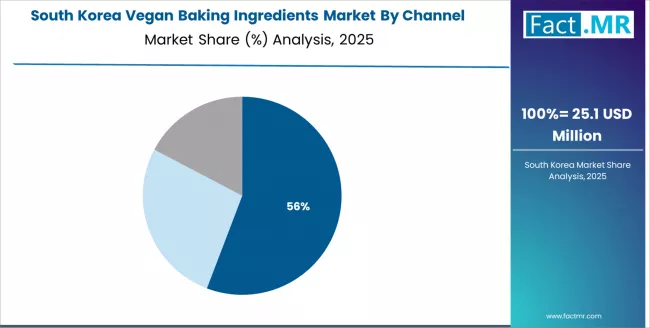
Revenue from vegan baking ingredients in South Korea is expanding at a CAGR of 5.9%, supported by premium ingredient positioning, growing health trend adoption, and expanding Western dietary preference integration throughout urban consumer markets and premium food applications. The country's sophisticated consumer culture and quality focus are driving high-end vegan ingredient utilization in premium applications. Leading ingredient importers and food manufacturers are establishing advanced quality control and application development capabilities.
- Growing health trend adoption and wellness lifestyle integration are creating opportunities for premium vegan ingredients throughout major urban markets and health-conscious consumer communities emphasizing natural and sustainable food choices.
- Expanding Western dietary preferences and international food culture acceptance are driving demand for imported vegan ingredients meeting Korean taste preferences and quality expectations across premium food applications.
- Premium ingredient positioning and luxury food market development are supporting high-end vegan ingredient availability that emphasizes quality, health benefits, and ethical positioning throughout sophisticated consumer segments.
- Advanced food technology capabilities and innovation focus are enabling vegan ingredient application optimization including functionality enhancement, processing compatibility, and formulation development throughout major food research centers.
Japan Shows Quality Excellence with Health Consciousness and Premium Positioning
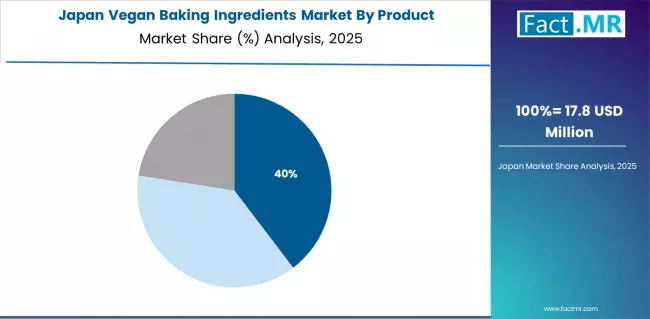
Revenue from vegan baking ingredients in Japan is expanding at a CAGR of 5.5%, driven by exceptional quality standards, established health consciousness culture, and premium ingredient positioning emphasizing safety, functionality, and performance excellence in vegan applications. The country's commitment to product quality and health awareness are creating opportunities for ultra-high-quality vegan ingredient solutions. Leading food manufacturers and ingredient companies are establishing comprehensive quality control and health positioning programs.
- Exceptional quality standards and rigorous safety requirements are creating demand for ultra-high-quality vegan ingredients meeting Japanese pharmaceutical-grade standards and comprehensive safety verification across food manufacturing facilities.
- Established health consciousness culture and preventive nutrition awareness are driving adoption of vegan ingredients supporting health positioning and dietary optimization among quality-focused consumer segments.
- Premium ingredient positioning and luxury food market development are enabling distribution of specialized vegan ingredients that combine functional effectiveness with premium health positioning and quality assurance throughout high-end food applications.
- Advanced analytical capabilities and comprehensive quality control systems are ensuring superior vegan ingredient consistency and performance throughout major manufacturing regions and quality-focused food production facilities.
Europe Market Split by Countries
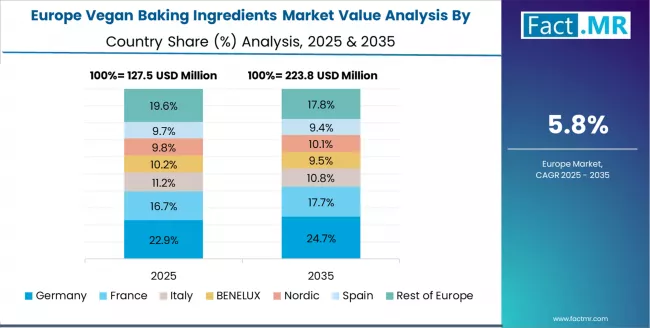
The vegan baking ingredients market in Europe is projected to grow from USD 153.0 million in 2025 to USD 282.0 million by 2035, registering a CAGR of 6.3% over the forecast period. Germany is expected to maintain leadership with a 29.5% market share in 2025, moderating to 29.2% by 2035, supported by sustainability leadership, advanced organic markets, and comprehensive ingredient technology development.
The United Kingdom follows with 23.0% in 2025, projected at 23.2% by 2035, driven by ethical consumption trends, retail chain sustainability requirements, and expanding plant-based market development. France holds 18.0% in 2025, expected to reach 18.3% by 2035 on the back of premium culinary culture and artisanal quality development. Italy commands 11.5% in 2025, rising slightly to 11.7% by 2035, while Spain accounts for 8.5% in 2025, reaching 8.7% by 2035 aided by health consciousness growth and food processing expansion. The Netherlands maintains 4.5% in 2025, up to 4.6% by 2035 due to advanced food technology capabilities and ingredient trading expertise. The Rest of Europe region, including Nordic countries, Central & Eastern Europe, and other markets, is anticipated to hold 5.0% in 2025 and 4.3% by 2035, reflecting steady growth in plant-based awareness and sustainable ingredient adoption.
Competitive Landscape of the Vegan Baking Ingredients Market
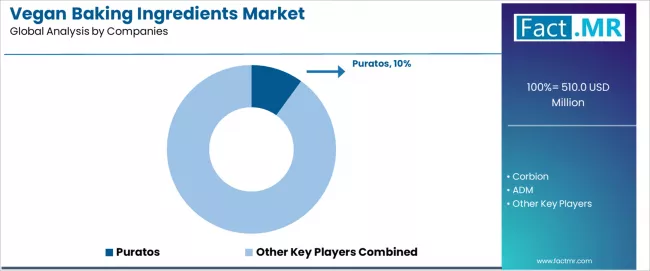
The vegan baking ingredients market is characterized by competition among established ingredient manufacturers, specialty plant-based companies, and biotechnology firms. Companies are investing in plant protein technology development, functional enhancement research, sustainable sourcing programs, and application-specific solution development to deliver effective, sustainable, and cost-competitive vegan baking ingredient solutions. Innovation in fermentation technologies, binding system optimization, and clean-label formulations is central to strengthening market position and competitive advantage.
Puratos leads the market with a 10.0% share, offering comprehensive plant-based bakery solutions with a focus on industrial applications, functional performance optimization, and technical support across diverse commercial baking and food manufacturing sectors. The company has announced major vegan ingredient production capacity expansions across European and American facilities, with plans to incorporate advanced fermentation technologies and sustainable ingredient sourcing programs, with facility upgrades initiated in 2024 and enhanced plant-based production capabilities planned for 2026. Corbion provides innovative functional ingredient solutions with emphasis on biotechnology applications, having advanced their vegan ingredient portfolio strategy by expanding fermentation-based production capabilities and developing specialized binding and preservation solutions for commercial baking applications.
ADM delivers comprehensive plant protein and ingredient solutions with focus on scalability and cost optimization for industrial applications. Ingredion offers functional ingredient technologies including specialty starches and binding systems. Tate & Lyle specializes in sweetening and texturing solutions for vegan applications. Cargill focuses on plant-based oils, proteins, and functional ingredients. DSM-Firmenich provides biofunctional ingredients and nutritional enhancement solutions. Kerry offers bakery systems and application-specific formulations. Roquette specializes in plant-based proteins and functional ingredients. DuPont delivers ingredient technologies and application support services serving diverse vegan baking applications.
Vegan Baking Ingredients Market - Stakeholder Contribution Framework
Vegan baking ingredients represent a specialized ingredient segment within plant-based food manufacturing, projected to grow from USD 510 million in 2025 to USD 940 million by 2035 at a 6.8% CAGR. These plant-derived ingredients—primarily egg replacers, plant-based fats, and dairy alternatives—serve as critical formulation components in commercial bakeries, food manufacturing, and retail applications where animal product replacement, ethical compliance, and functional performance are essential. Market expansion is driven by increasing plant-based diet adoption, growing vegan lifestyle trends, expanding commercial bakery vegan product development, and rising demand for sustainable and cruelty-free ingredient solutions across diverse food manufacturing segments.
How Regulatory Bodies Could Support Vegan Ingredient Development and Market Growth
- Vegan Labeling Standards and Certification: Establish comprehensive regulatory frameworks defining vegan ingredient criteria, certification processes, and labeling requirements that ensure consumer transparency while enabling clear market positioning and competitive differentiation across diverse food manufacturing applications.
- Safety Assessment and Novel Ingredient Approval: Develop streamlined evaluation procedures for innovative vegan ingredients, including biotechnology-derived components, fermentation products, and novel protein sources that ensure consumer safety while facilitating innovation and market access for emerging ingredient technologies.
- Nutritional Enhancement and Fortification Guidelines: Create comprehensive standards for vegan ingredient nutritional optimization, including protein quality assessment, micronutrient bioavailability evaluation, and functional benefit substantiation that support healthy product development while maintaining regulatory compliance.
- Environmental Impact Assessment and Sustainability Standards: Implement evaluation frameworks for vegan ingredient production including carbon footprint assessment, water usage evaluation, and land use efficiency measurement that support environmental responsibility while enabling sustainability claims and market positioning.
- International Trade Facilitation and Harmonization: Facilitate global market access through standardized vegan ingredient definitions, mutual recognition agreements, and trade barrier reduction that support international commerce while maintaining quality and safety standards.
How Plant-Based Industry Organizations Could Advance Market Development and Consumer Education
- Consumer Education and Awareness Campaigns: Develop comprehensive marketing and educational programs that communicate vegan ingredient benefits, environmental advantages, and ethical considerations while supporting market growth and consumer acceptance across diverse demographic segments and geographic markets.
- Technical Standards and Best Practice Development: Establish industry-wide guidelines for vegan ingredient quality, functionality assessment, and application optimization that ensure consistent performance while supporting supplier development and customer satisfaction across diverse applications.
- Sustainability and Ethical Sourcing Standards: Create comprehensive frameworks for responsible vegan ingredient sourcing including fair trade principles, environmental impact minimization, and supply chain transparency that support ethical development while ensuring long-term sustainability.
- Innovation Collaboration and Research Networks: Facilitate partnerships between ingredient suppliers, food manufacturers, research institutions, and technology providers to advance vegan ingredient development while supporting innovation in functionality, processing, and application optimization.
- Market Access and Distribution Support: Provide resources and guidance for vegan ingredient market entry including regulatory compliance assistance, customer connection facilitation, and distribution network development that support industry growth and competitive development.
How Vegan Ingredient Manufacturers Could Drive Innovation and Market Leadership
- Advanced Plant Protein Technology Development: Invest in cutting-edge protein extraction, modification, and functionality enhancement technologies that improve vegan ingredient performance while maintaining cost competitiveness and sustainability credentials for commercial applications.
- Fermentation and Biotechnology Innovation: Develop comprehensive biotechnology platforms including precision fermentation, cellular agriculture, and enzymatic production methods that enable scalable vegan ingredient production while reducing environmental impact and improving functional properties.
- Application-Specific Product Development: Create specialized vegan ingredient formulations optimized for specific baking applications including industrial bread production, artisanal pastries, and specialty desserts that address unique technical requirements while maintaining performance standards.
- Sustainable Production and Supply Chain Excellence: Implement environmentally responsible manufacturing practices including renewable energy utilization, waste minimization programs, and circular economy integration that reduce environmental impact while ensuring reliable supply chain performance.
- Customer Technical Support and Innovation Services: Establish comprehensive support capabilities including formulation assistance, baking trials, troubleshooting expertise, and regulatory guidance that strengthen customer relationships while enabling successful product development and market implementation.
How Commercial Bakeries and Food Manufacturers Could Optimize Vegan Ingredient Integration
- Strategic Sourcing and Supplier Partnership Development: Develop comprehensive evaluation criteria for vegan ingredient suppliers including quality specifications, technical support capabilities, sustainability credentials, and cost optimization that ensure optimal supplier selection while supporting long-term partnership success.
- Formulation Development and Recipe Optimization: Implement systematic development methodologies utilizing pilot testing, sensory evaluation, and consumer acceptance studies that maximize vegan ingredient performance while maintaining product quality, taste satisfaction, and cost-effectiveness.
- Production Process Adaptation and Equipment Optimization: Modify manufacturing processes including mixing protocols, temperature control, and handling procedures that accommodate vegan ingredient characteristics while maintaining production efficiency and quality consistency throughout commercial operations.
- Marketing and Consumer Communication Excellence: Develop comprehensive marketing strategies that effectively communicate vegan benefits, ethical advantages, and sustainability credentials while supporting brand differentiation and consumer preference alignment across target market segments.
- Quality Assurance and Performance Monitoring: Establish systematic testing and evaluation procedures for vegan ingredient applications including functionality assessment, shelf-life evaluation, and consumer feedback analysis that ensure consistent performance while enabling continuous improvement.
How Research Institutions Could Advance Vegan Ingredient Science and Technology
- Fundamental Research and Scientific Understanding: Conduct comprehensive studies investigating plant protein functionality, ingredient interactions, and processing behavior that advance scientific knowledge while informing technology development and application optimization strategies.
- Novel Ingredient Discovery and Development: Explore innovative vegan ingredient sources including underutilized plants, algae systems, and fermentation products that provide enhanced functionality while addressing current performance limitations and expanding application possibilities.
- Processing Technology Innovation and Optimization: Advance processing methods including extraction optimization, modification techniques, and stabilization technologies that improve vegan ingredient performance while reducing production costs and environmental impact.
- Nutrition Science and Health Benefit Research: Investigate vegan ingredient nutritional profiles, bioavailability characteristics, and health outcomes that support evidence-based marketing while informing product development priorities and consumer education initiatives.
- Consumer Behavior and Market Research: Study consumer preferences, acceptance factors, and purchasing decisions related to vegan ingredients that inform product development strategies while identifying market opportunities and communication approaches for effective consumer engagement.
How Investment Community Could Support Market Growth and Innovation Excellence
- Technology Development and Innovation Investment: Provide capital for breakthrough ingredient technologies, biotechnology platforms, and processing innovations that advance vegan ingredient capabilities while improving performance characteristics and cost competitiveness for commercial applications.
- Production Capacity and Infrastructure Development: Finance manufacturing facility construction, processing equipment acquisition, and distribution system development that address growing market demand while maintaining quality standards and operational efficiency throughout expansion phases.
- Sustainable Agriculture and Supply Chain Investment: Support sustainable farming initiatives, ingredient sourcing programs, and supply chain optimization projects that ensure reliable raw material availability while reducing environmental impact and supporting ethical sourcing practices.
- Market Development and Brand Building Support: Provide funding for marketing initiatives, consumer education programs, and brand development projects that increase market awareness while supporting category growth and consumer acceptance across diverse demographic segments.
- Research and Development Collaboration Funding: Finance academic partnerships, industry research programs, and technology transfer initiatives that advance scientific understanding while accelerating innovation development and commercial application of vegan ingredient technologies.**
Key Players in the Vegan Baking Ingredients Market
- Puratos
- Corbion
- ADM
- Ingredion
- Tate & Lyle
- Cargill
- DSM-Firmenich
- Kerry
- Roquette
- DuPont
Scope of the Report
| Items | Values |
|---|---|
| Quantitative Units (2025) | USD 510 million |
| Product Type | Egg replacers & binders, Plant-based fats & shortenings, Dairy replacers |
| Ingredient Source | Soy & pea proteins, Coconut/oil blends, Specialty hydrocolloids |
| Channel | Industrial bakery customers, Retail/foodservice, Online ingredient sales |
| Regions Covered | North America, Europe, Asia Pacific, Latin America, Middle East & Africa |
| Countries Covered | USA, Mexico, Germany, France, UK, South Korea, Japan, and 40+ countries |
| Key Companies Profiled | Puratos, Corbion, ADM, Ingredion, Tate & Lyle, Cargill |
| Additional Attributes | Dollar sales by product type and ingredient source category, regional demand trends, competitive landscape, technological advancements in plant-based ingredient production, sustainability development, biotechnology innovation, and commercial application optimization |
Vegan Baking Ingredients Market by Segments
-
Product :
- Egg replacers & binders
- Plant-based fats & shortenings
- Dairy replacers
-
Ingredient Source :
- Soy & pea proteins
- Coconut/oil blends
- Specialty hydrocolloids
-
Channel :
- Industrial bakery customers
- Retail/foodservice
- Online ingredient sales
-
Region :
-
North America
- United States
- Canada
- Mexico
-
Europe
- Germany
- United Kingdom
- France
- Italy
- Spain
- Netherlands
- Rest of Europe
-
Asia Pacific
- Japan
- South Korea
- China
- Australia
- Rest of Asia Pacific
-
Latin America
- Brazil
- Argentina
- Rest of Latin America
-
Middle East & Africa
- Kingdom of Saudi Arabia
- Other GCC Countries
- South Africa
- Rest of Middle East & Africa
-
Table of Content
- Executive Summary
- Global Market Outlook
- Demand to side Trends
- Supply to side Trends
- Technology Roadmap Analysis
- Analysis and Recommendations
- Market Overview
- Market Coverage / Taxonomy
- Market Definition / Scope / Limitations
- Market Background
- Market Dynamics
- Drivers
- Restraints
- Opportunity
- Trends
- Scenario Forecast
- Demand in Optimistic Scenario
- Demand in Likely Scenario
- Demand in Conservative Scenario
- Opportunity Map Analysis
- Product Life Cycle Analysis
- Supply Chain Analysis
- Investment Feasibility Matrix
- Value Chain Analysis
- PESTLE and Porter’s Analysis
- Regulatory Landscape
- Regional Parent Market Outlook
- Production and Consumption Statistics
- Import and Export Statistics
- Market Dynamics
- Global Market Analysis 2020 to 2024 and Forecast, 2025 to 2035
- Historical Market Size Value (USD Million) Analysis, 2020 to 2024
- Current and Future Market Size Value (USD Million) Projections, 2025 to 2035
- Y to o to Y Growth Trend Analysis
- Absolute $ Opportunity Analysis
- Global Market Pricing Analysis 2020 to 2024 and Forecast 2025 to 2035
- Global Market Analysis 2020 to 2024 and Forecast 2025 to 2035, By Product
- Introduction / Key Findings
- Historical Market Size Value (USD Million) Analysis By Product , 2020 to 2024
- Current and Future Market Size Value (USD Million) Analysis and Forecast By Product , 2025 to 2035
- Egg replacers & binders
- Plant-based fats & shortenings
- Dairy replacers
- Y to o to Y Growth Trend Analysis By Product , 2020 to 2024
- Absolute $ Opportunity Analysis By Product , 2025 to 2035
- Global Market Analysis 2020 to 2024 and Forecast 2025 to 2035, By Channel
- Introduction / Key Findings
- Historical Market Size Value (USD Million) Analysis By Channel, 2020 to 2024
- Current and Future Market Size Value (USD Million) Analysis and Forecast By Channel, 2025 to 2035
- Industrial bakery customers
- Retail/foodservice
- Online ingredient sales
- Y to o to Y Growth Trend Analysis By Channel, 2020 to 2024
- Absolute $ Opportunity Analysis By Channel, 2025 to 2035
- Global Market Analysis 2020 to 2024 and Forecast 2025 to 2035, By Region
- Introduction
- Historical Market Size Value (USD Million) Analysis By Region, 2020 to 2024
- Current Market Size Value (USD Million) Analysis and Forecast By Region, 2025 to 2035
- North America
- Latin America
- Western Europe
- Eastern Europe
- East Asia
- South Asia and Pacific
- Middle East & Africa
- Market Attractiveness Analysis By Region
- North America Market Analysis 2020 to 2024 and Forecast 2025 to 2035, By Country
- Historical Market Size Value (USD Million) Trend Analysis By Market Taxonomy, 2020 to 2024
- Market Size Value (USD Million) Forecast By Market Taxonomy, 2025 to 2035
- By Country
- USA
- Canada
- Mexico
- By Product
- By Channel
- By Country
- Market Attractiveness Analysis
- By Country
- By Product
- By Channel
- Key Takeaways
- Latin America Market Analysis 2020 to 2024 and Forecast 2025 to 2035, By Country
- Historical Market Size Value (USD Million) Trend Analysis By Market Taxonomy, 2020 to 2024
- Market Size Value (USD Million) Forecast By Market Taxonomy, 2025 to 2035
- By Country
- Brazil
- Chile
- Rest of Latin America
- By Product
- By Channel
- By Country
- Market Attractiveness Analysis
- By Country
- By Product
- By Channel
- Key Takeaways
- Western Europe Market Analysis 2020 to 2024 and Forecast 2025 to 2035, By Country
- Historical Market Size Value (USD Million) Trend Analysis By Market Taxonomy, 2020 to 2024
- Market Size Value (USD Million) Forecast By Market Taxonomy, 2025 to 2035
- By Country
- Germany
- UK
- Italy
- Spain
- France
- Nordic
- BENELUX
- Rest of Western Europe
- By Product
- By Channel
- By Country
- Market Attractiveness Analysis
- By Country
- By Product
- By Channel
- Key Takeaways
- Eastern Europe Market Analysis 2020 to 2024 and Forecast 2025 to 2035, By Country
- Historical Market Size Value (USD Million) Trend Analysis By Market Taxonomy, 2020 to 2024
- Market Size Value (USD Million) Forecast By Market Taxonomy, 2025 to 2035
- By Country
- Russia
- Poland
- Hungary
- Balkan & Baltic
- Rest of Eastern Europe
- By Product
- By Channel
- By Country
- Market Attractiveness Analysis
- By Country
- By Product
- By Channel
- Key Takeaways
- East Asia Market Analysis 2020 to 2024 and Forecast 2025 to 2035, By Country
- Historical Market Size Value (USD Million) Trend Analysis By Market Taxonomy, 2020 to 2024
- Market Size Value (USD Million) Forecast By Market Taxonomy, 2025 to 2035
- By Country
- China
- Japan
- South Korea
- By Product
- By Channel
- By Country
- Market Attractiveness Analysis
- By Country
- By Product
- By Channel
- Key Takeaways
- South Asia and Pacific Market Analysis 2020 to 2024 and Forecast 2025 to 2035, By Country
- Historical Market Size Value (USD Million) Trend Analysis By Market Taxonomy, 2020 to 2024
- Market Size Value (USD Million) Forecast By Market Taxonomy, 2025 to 2035
- By Country
- India
- ASEAN
- Australia & New Zealand
- Rest of South Asia and Pacific
- By Product
- By Channel
- By Country
- Market Attractiveness Analysis
- By Country
- By Product
- By Channel
- Key Takeaways
- Middle East & Africa Market Analysis 2020 to 2024 and Forecast 2025 to 2035, By Country
- Historical Market Size Value (USD Million) Trend Analysis By Market Taxonomy, 2020 to 2024
- Market Size Value (USD Million) Forecast By Market Taxonomy, 2025 to 2035
- By Country
- Kingdom of Saudi Arabia
- Other GCC Countries
- Turkiye
- South Africa
- Other African Union
- Rest of Middle East & Africa
- By Product
- By Channel
- By Country
- Market Attractiveness Analysis
- By Country
- By Product
- By Channel
- Key Takeaways
- Key Countries Market Analysis
- USA
- Pricing Analysis
- Market Share Analysis, 2024
- By Product
- By Channel
- Canada
- Pricing Analysis
- Market Share Analysis, 2024
- By Product
- By Channel
- Mexico
- Pricing Analysis
- Market Share Analysis, 2024
- By Product
- By Channel
- Brazil
- Pricing Analysis
- Market Share Analysis, 2024
- By Product
- By Channel
- Chile
- Pricing Analysis
- Market Share Analysis, 2024
- By Product
- By Channel
- Germany
- Pricing Analysis
- Market Share Analysis, 2024
- By Product
- By Channel
- UK
- Pricing Analysis
- Market Share Analysis, 2024
- By Product
- By Channel
- Italy
- Pricing Analysis
- Market Share Analysis, 2024
- By Product
- By Channel
- Spain
- Pricing Analysis
- Market Share Analysis, 2024
- By Product
- By Channel
- France
- Pricing Analysis
- Market Share Analysis, 2024
- By Product
- By Channel
- India
- Pricing Analysis
- Market Share Analysis, 2024
- By Product
- By Channel
- ASEAN
- Pricing Analysis
- Market Share Analysis, 2024
- By Product
- By Channel
- Australia & New Zealand
- Pricing Analysis
- Market Share Analysis, 2024
- By Product
- By Channel
- China
- Pricing Analysis
- Market Share Analysis, 2024
- By Product
- By Channel
- Japan
- Pricing Analysis
- Market Share Analysis, 2024
- By Product
- By Channel
- South Korea
- Pricing Analysis
- Market Share Analysis, 2024
- By Product
- By Channel
- Russia
- Pricing Analysis
- Market Share Analysis, 2024
- By Product
- By Channel
- Poland
- Pricing Analysis
- Market Share Analysis, 2024
- By Product
- By Channel
- Hungary
- Pricing Analysis
- Market Share Analysis, 2024
- By Product
- By Channel
- Kingdom of Saudi Arabia
- Pricing Analysis
- Market Share Analysis, 2024
- By Product
- By Channel
- Turkiye
- Pricing Analysis
- Market Share Analysis, 2024
- By Product
- By Channel
- South Africa
- Pricing Analysis
- Market Share Analysis, 2024
- By Product
- By Channel
- USA
- Market Structure Analysis
- Competition Dashboard
- Competition Benchmarking
- Market Share Analysis of Top Players
- By Regional
- By Product
- By Channel
- Competition Analysis
- Competition Deep Dive
- Puratos
- Overview
- Product Portfolio
- Profitability by Market Segments (Product/Age /Sales Channel/Region)
- Sales Footprint
- Strategy Overview
- Marketing Strategy
- Product Strategy
- Channel Strategy
- Corbion
- ADM
- Ingredion
- Tate & Lyle
- Cargill
- DSM-Firmenich
- Kerry
- Roquette
- DuPont
- Puratos
- Competition Deep Dive
- Assumptions & Acronyms Used
- Research Methodology
List Of Table
- Table 1: Global Market Value (USD Million) Forecast by Region, 2020 to 2035
- Table 2: Global Market Value (USD Million) Forecast by Product , 2020 to 2035
- Table 3: Global Market Value (USD Million) Forecast by Channel, 2020 to 2035
- Table 4: North America Market Value (USD Million) Forecast by Country, 2020 to 2035
- Table 5: North America Market Value (USD Million) Forecast by Product , 2020 to 2035
- Table 6: North America Market Value (USD Million) Forecast by Channel, 2020 to 2035
- Table 7: Latin America Market Value (USD Million) Forecast by Country, 2020 to 2035
- Table 8: Latin America Market Value (USD Million) Forecast by Product , 2020 to 2035
- Table 9: Latin America Market Value (USD Million) Forecast by Channel, 2020 to 2035
- Table 10: Western Europe Market Value (USD Million) Forecast by Country, 2020 to 2035
- Table 11: Western Europe Market Value (USD Million) Forecast by Product , 2020 to 2035
- Table 12: Western Europe Market Value (USD Million) Forecast by Channel, 2020 to 2035
- Table 13: Eastern Europe Market Value (USD Million) Forecast by Country, 2020 to 2035
- Table 14: Eastern Europe Market Value (USD Million) Forecast by Product , 2020 to 2035
- Table 15: Eastern Europe Market Value (USD Million) Forecast by Channel, 2020 to 2035
- Table 16: East Asia Market Value (USD Million) Forecast by Country, 2020 to 2035
- Table 17: East Asia Market Value (USD Million) Forecast by Product , 2020 to 2035
- Table 18: East Asia Market Value (USD Million) Forecast by Channel, 2020 to 2035
- Table 19: South Asia and Pacific Market Value (USD Million) Forecast by Country, 2020 to 2035
- Table 20: South Asia and Pacific Market Value (USD Million) Forecast by Product , 2020 to 2035
- Table 21: South Asia and Pacific Market Value (USD Million) Forecast by Channel, 2020 to 2035
- Table 22: Middle East & Africa Market Value (USD Million) Forecast by Country, 2020 to 2035
- Table 23: Middle East & Africa Market Value (USD Million) Forecast by Product , 2020 to 2035
- Table 24: Middle East & Africa Market Value (USD Million) Forecast by Channel, 2020 to 2035
List Of Figures
- Figure 1: Global Market Pricing Analysis
- Figure 2: Global Market Value (USD Million) Forecast 2020-2035
- Figure 3: Global Market Value Share and BPS Analysis by Product , 2025 and 2035
- Figure 4: Global Market Y to o to Y Growth Comparison by Product , 2025-2035
- Figure 5: Global Market Attractiveness Analysis by Product
- Figure 6: Global Market Value Share and BPS Analysis by Channel, 2025 and 2035
- Figure 7: Global Market Y to o to Y Growth Comparison by Channel, 2025-2035
- Figure 8: Global Market Attractiveness Analysis by Channel
- Figure 9: Global Market Value (USD Million) Share and BPS Analysis by Region, 2025 and 2035
- Figure 10: Global Market Y to o to Y Growth Comparison by Region, 2025-2035
- Figure 11: Global Market Attractiveness Analysis by Region
- Figure 12: North America Market Incremental Dollar Opportunity, 2025-2035
- Figure 13: Latin America Market Incremental Dollar Opportunity, 2025-2035
- Figure 14: Western Europe Market Incremental Dollar Opportunity, 2025-2035
- Figure 15: Eastern Europe Market Incremental Dollar Opportunity, 2025-2035
- Figure 16: East Asia Market Incremental Dollar Opportunity, 2025-2035
- Figure 17: South Asia and Pacific Market Incremental Dollar Opportunity, 2025-2035
- Figure 18: Middle East & Africa Market Incremental Dollar Opportunity, 2025-2035
- Figure 19: North America Market Value Share and BPS Analysis by Country, 2025 and 2035
- Figure 20: North America Market Value Share and BPS Analysis by Product , 2025 and 2035
- Figure 21: North America Market Y to o to Y Growth Comparison by Product , 2025-2035
- Figure 22: North America Market Attractiveness Analysis by Product
- Figure 23: North America Market Value Share and BPS Analysis by Channel, 2025 and 2035
- Figure 24: North America Market Y to o to Y Growth Comparison by Channel, 2025-2035
- Figure 25: North America Market Attractiveness Analysis by Channel
- Figure 26: Latin America Market Value Share and BPS Analysis by Country, 2025 and 2035
- Figure 27: Latin America Market Value Share and BPS Analysis by Product , 2025 and 2035
- Figure 28: Latin America Market Y to o to Y Growth Comparison by Product , 2025-2035
- Figure 29: Latin America Market Attractiveness Analysis by Product
- Figure 30: Latin America Market Value Share and BPS Analysis by Channel, 2025 and 2035
- Figure 31: Latin America Market Y to o to Y Growth Comparison by Channel, 2025-2035
- Figure 32: Latin America Market Attractiveness Analysis by Channel
- Figure 33: Western Europe Market Value Share and BPS Analysis by Country, 2025 and 2035
- Figure 34: Western Europe Market Value Share and BPS Analysis by Product , 2025 and 2035
- Figure 35: Western Europe Market Y to o to Y Growth Comparison by Product , 2025-2035
- Figure 36: Western Europe Market Attractiveness Analysis by Product
- Figure 37: Western Europe Market Value Share and BPS Analysis by Channel, 2025 and 2035
- Figure 38: Western Europe Market Y to o to Y Growth Comparison by Channel, 2025-2035
- Figure 39: Western Europe Market Attractiveness Analysis by Channel
- Figure 40: Eastern Europe Market Value Share and BPS Analysis by Country, 2025 and 2035
- Figure 41: Eastern Europe Market Value Share and BPS Analysis by Product , 2025 and 2035
- Figure 42: Eastern Europe Market Y to o to Y Growth Comparison by Product , 2025-2035
- Figure 43: Eastern Europe Market Attractiveness Analysis by Product
- Figure 44: Eastern Europe Market Value Share and BPS Analysis by Channel, 2025 and 2035
- Figure 45: Eastern Europe Market Y to o to Y Growth Comparison by Channel, 2025-2035
- Figure 46: Eastern Europe Market Attractiveness Analysis by Channel
- Figure 47: East Asia Market Value Share and BPS Analysis by Country, 2025 and 2035
- Figure 48: East Asia Market Value Share and BPS Analysis by Product , 2025 and 2035
- Figure 49: East Asia Market Y to o to Y Growth Comparison by Product , 2025-2035
- Figure 50: East Asia Market Attractiveness Analysis by Product
- Figure 51: East Asia Market Value Share and BPS Analysis by Channel, 2025 and 2035
- Figure 52: East Asia Market Y to o to Y Growth Comparison by Channel, 2025-2035
- Figure 53: East Asia Market Attractiveness Analysis by Channel
- Figure 54: South Asia and Pacific Market Value Share and BPS Analysis by Country, 2025 and 2035
- Figure 55: South Asia and Pacific Market Value Share and BPS Analysis by Product , 2025 and 2035
- Figure 56: South Asia and Pacific Market Y to o to Y Growth Comparison by Product , 2025-2035
- Figure 57: South Asia and Pacific Market Attractiveness Analysis by Product
- Figure 58: South Asia and Pacific Market Value Share and BPS Analysis by Channel, 2025 and 2035
- Figure 59: South Asia and Pacific Market Y to o to Y Growth Comparison by Channel, 2025-2035
- Figure 60: South Asia and Pacific Market Attractiveness Analysis by Channel
- Figure 61: Middle East & Africa Market Value Share and BPS Analysis by Country, 2025 and 2035
- Figure 62: Middle East & Africa Market Value Share and BPS Analysis by Product , 2025 and 2035
- Figure 63: Middle East & Africa Market Y to o to Y Growth Comparison by Product , 2025-2035
- Figure 64: Middle East & Africa Market Attractiveness Analysis by Product
- Figure 65: Middle East & Africa Market Value Share and BPS Analysis by Channel, 2025 and 2035
- Figure 66: Middle East & Africa Market Y to o to Y Growth Comparison by Channel, 2025-2035
- Figure 67: Middle East & Africa Market Attractiveness Analysis by Channel
- Figure 68: Global Market - Tier Structure Analysis
- Figure 69: Global Market - Company Share Analysis
- FAQs -
How big is the vegan baking ingredients market in 2025?
The global vegan baking ingredients market is estimated to be valued at USD 510.0 million in 2025.
What will be the size of vegan baking ingredients market in 2035?
The market size for the vegan baking ingredients market is projected to reach USD 984.7 million by 2035.
How much will be the vegan baking ingredients market growth between 2025 and 2035?
The vegan baking ingredients market is expected to grow at a 6.8% CAGR between 2025 and 2035.
What are the key product types in the vegan baking ingredients market?
The key product types in vegan baking ingredients market are egg replacers & binders, plant-based fats & shortenings and dairy replacers.
Which channel segment to contribute significant share in the vegan baking ingredients market in 2025?
In terms of channel, industrial bakery customers segment to command 58.0% share in the vegan baking ingredients market in 2025.